In making this list, I confirmed my impression that the artform of comics has reached a creative apex in recent years. The comics produced from 2000-2009 are varied and encompass a diversity and general high level of quality previously unimagined for an artform once considered pulpy trash for children. This is a great time to be reading comics, and this list is my perspective on this especially fecund era's most satisfying works.
60. CEREBUS
by Dave Sim & Gerhard, 1998-2004
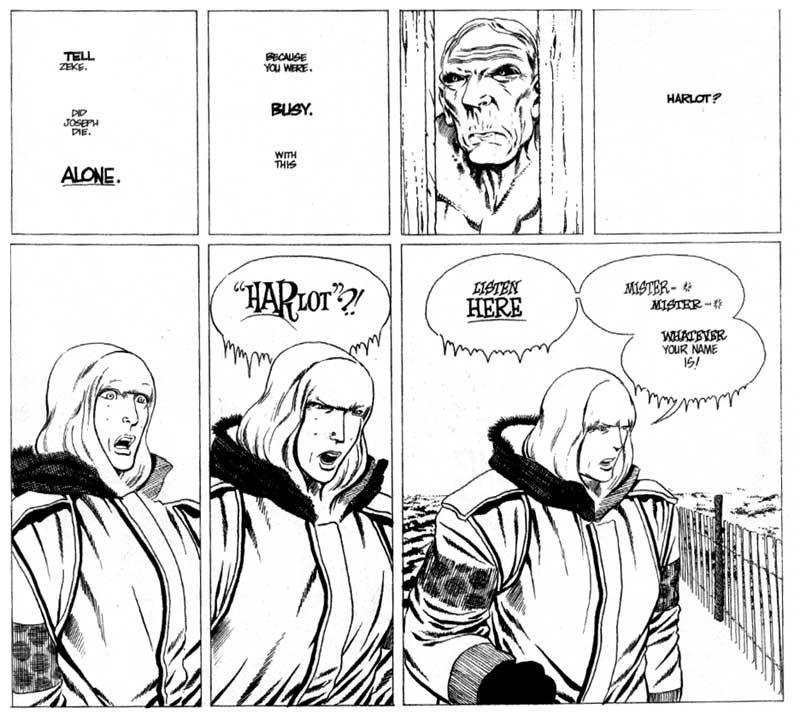 Dave Sim's long-running warrior aardvark series Cerebus finally wrapped up, after 300 issues and 27 years, in early 2004, marking the end of Sim's grand project to tell the life story of his title character. Of course, by the time of the 300th issue, the book had changed dramatically, increasingly focusing on Sim's oddball ideas, including his (to say the least) troubled attitude towards women and, especially in the last few extended story arcs, on his, ahem, unusual ideas about religion. What's fascinating about Cerebus in these later stretches is watching Sim become a better and better visual artist with every page, restlessly experimenting and honing his craft, while descending further and further into absolutely loony theology and misanthropy. The nadir, in terms of both ideas and visuals, is the lengthy stretch in Latter Days where Sim offers up, in eye-strainingly small text, Cerebus' line-by-line reinterpretation of the book of Genesis according to Sim's own idiosyncratic reading of the first book of the Bible.
Dave Sim's long-running warrior aardvark series Cerebus finally wrapped up, after 300 issues and 27 years, in early 2004, marking the end of Sim's grand project to tell the life story of his title character. Of course, by the time of the 300th issue, the book had changed dramatically, increasingly focusing on Sim's oddball ideas, including his (to say the least) troubled attitude towards women and, especially in the last few extended story arcs, on his, ahem, unusual ideas about religion. What's fascinating about Cerebus in these later stretches is watching Sim become a better and better visual artist with every page, restlessly experimenting and honing his craft, while descending further and further into absolutely loony theology and misanthropy. The nadir, in terms of both ideas and visuals, is the lengthy stretch in Latter Days where Sim offers up, in eye-strainingly small text, Cerebus' line-by-line reinterpretation of the book of Genesis according to Sim's own idiosyncratic reading of the first book of the Bible.So what's Cerebus doing on this list, anyway, if its glory days were already behind it? Well, the two-book extended story arc represented by the collections Going Home and Form and Void are some of Sim's finest work, at least as an artist. Bolstered by the gorgeous background work of his collaborator Gerhard, throughout these books Sim experimented with form and style, breaking down the page in innovative ways while introducing more of his characteristic metafictional elements. A sequence during a blizzard is especially evocative, as the snow seems to flow in white streaks across the page. He offers up dead-on caricatures of Ernest Hemingway and F. Scott Fitzgerald, even aping the latter's literary style for certain sequences.
Even in the less successful later books, Sim's imagination and feel for the comic page comes across. The final book, The Last Day, opens with one of the most formally dazzling sequences in comics, as Sim collages in photocopies and draws processes happening on both the cosmic and molecular scale, while seamlessly incorporating dense footnotes and textual effects. That this formal ingenuity is linked to some of Sim's silliest ideas only slightly takes away from its overall impact. These books aren't without their problems in terms of the narrative and ideas, but there are few comics that display more formal panache or sheer visual wonder, and for that alone it deserves a place on this list. Cerebus, at times one of the best comics around, ended in the 2000s, and any list that didn't acknowledge this fact would feel somehow incomplete. [buy] | [buy] | [buy] | [buy]
59. SLEEPER
by Ed Brubaker & Sean Phillips, 2003-2005
 It's fairly routine by now to inject a noir sensibility into superhero comics, but few series have done it better than Sleeper, written by Ed Brubaker with art by Sean Phillips. In Brubaker's conception, the superhero concepts and powers mostly take a backseat to strong character writing and crime fiction tropes, as he follows deep-cover secret agent Holden Carver as he infilitrates a powerful criminal organization. The problem? The only man who knows he's undercover, as opposed to a genuine crook, is in a coma. The series boasts a wealth of twists and turns, and all the double-crosses and intrigues one could expect, but its true worth is in its characters, in the way they change over time, always balancing just on the boundary line between good and evil. Moreover, as much as Brubaker underplays the superhero aspects of the story, Sleeper still boasts, bar none, the best use of superpowers in a mainstream comic. The character of Miss Misery, the series' femme fatale, is a woman beset by an illness that saps her strength unless she commits evil acts; the more bad things she does, the better she feels and the more powerful she grows. Over the course of the series, Brubaker exploits this unique "power" in inventive, revealing ways, placing his anti-heroine in paradoxical situations where Miss Misery's central dilemma creates strangely moving ramifications for her and those around her, including Holden. [buy] | [buy]
It's fairly routine by now to inject a noir sensibility into superhero comics, but few series have done it better than Sleeper, written by Ed Brubaker with art by Sean Phillips. In Brubaker's conception, the superhero concepts and powers mostly take a backseat to strong character writing and crime fiction tropes, as he follows deep-cover secret agent Holden Carver as he infilitrates a powerful criminal organization. The problem? The only man who knows he's undercover, as opposed to a genuine crook, is in a coma. The series boasts a wealth of twists and turns, and all the double-crosses and intrigues one could expect, but its true worth is in its characters, in the way they change over time, always balancing just on the boundary line between good and evil. Moreover, as much as Brubaker underplays the superhero aspects of the story, Sleeper still boasts, bar none, the best use of superpowers in a mainstream comic. The character of Miss Misery, the series' femme fatale, is a woman beset by an illness that saps her strength unless she commits evil acts; the more bad things she does, the better she feels and the more powerful she grows. Over the course of the series, Brubaker exploits this unique "power" in inventive, revealing ways, placing his anti-heroine in paradoxical situations where Miss Misery's central dilemma creates strangely moving ramifications for her and those around her, including Holden. [buy] | [buy]58. POPEYE AND OLIVE/P+O
by Richard McGuire, 2002
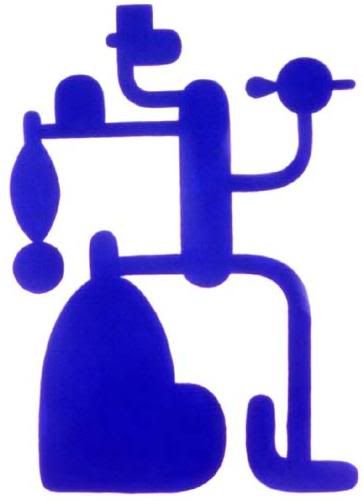 Richard McGuire has only a small body of work within comics, mostly limited to a few short stories (including the seminal "Here" from Raw) and his experiments with E.C. Segar's Popeye character. Collected in two French volumes, McGuire's Popeye drawings are abstract representations of the famous sailorman and his beanpole-thin girlfriend Olive Oyl. It's a demonstration of the inherent power of cartoon iconography: strip these familiar characters down to stylized outlines in a single primary color (either red or blue) and they're still recognizable, still resonant. On page after page, McGuire delineates Popeye and Olive with blobs and pipes shaped to suggest their cartoon figures. There's no narrative, just endless transformations and variations, McGuire riffing on these basic forms, demonstrating the variety of ways in which he can explore the same visuals, and the massive warping that Popeye can withstand while remaining recognizable and iconic. Popeye and Olive is the original collector's edition book, massively expensive and long unavailable (but excerpted in Dan Nadel's great anthology The Ganzfeld), while P+O is a sequel in which McGuire's improvisations take on a distinctly sexual nature, positioning his heroes within abstract narratives of desire and lust, like geometric porn.
Richard McGuire has only a small body of work within comics, mostly limited to a few short stories (including the seminal "Here" from Raw) and his experiments with E.C. Segar's Popeye character. Collected in two French volumes, McGuire's Popeye drawings are abstract representations of the famous sailorman and his beanpole-thin girlfriend Olive Oyl. It's a demonstration of the inherent power of cartoon iconography: strip these familiar characters down to stylized outlines in a single primary color (either red or blue) and they're still recognizable, still resonant. On page after page, McGuire delineates Popeye and Olive with blobs and pipes shaped to suggest their cartoon figures. There's no narrative, just endless transformations and variations, McGuire riffing on these basic forms, demonstrating the variety of ways in which he can explore the same visuals, and the massive warping that Popeye can withstand while remaining recognizable and iconic. Popeye and Olive is the original collector's edition book, massively expensive and long unavailable (but excerpted in Dan Nadel's great anthology The Ganzfeld), while P+O is a sequel in which McGuire's improvisations take on a distinctly sexual nature, positioning his heroes within abstract narratives of desire and lust, like geometric porn.57. THE TICKING
by Renee French, 2007
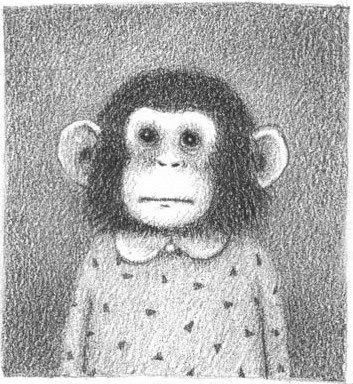 The Ticking relates the dark fable of Edison Steelhead, an isolated boy born with his eyes on the sides of his misshapen head, like a fish. His mother dies in childbirth, and his father, from whom he inherited this appearance, wants Edison to get plastic surgery to correct his looks. When Edison refuses, his father begins lavishing more of his attention on his new adopted "child," a monkey who he puts in a dress and introduces to Edison as a new sister. It's a strange book, then, to say the least, exploring the traumas and confusions of childhood through this unsettling story. French's delicate artwork only accentuates the eerie quality of Edison's struggle to come to terms with the world and his own uncertain place in it. French's beautifully rendered pencil drawings, enclosed within undersized panels isolated in large areas of white space, are haunting in the way they balance naturalism with surrealism. In the same way, French balances the tragedy of Edison's youth against her deadpan sense of humor and feel for unusual imagery. [buy]
The Ticking relates the dark fable of Edison Steelhead, an isolated boy born with his eyes on the sides of his misshapen head, like a fish. His mother dies in childbirth, and his father, from whom he inherited this appearance, wants Edison to get plastic surgery to correct his looks. When Edison refuses, his father begins lavishing more of his attention on his new adopted "child," a monkey who he puts in a dress and introduces to Edison as a new sister. It's a strange book, then, to say the least, exploring the traumas and confusions of childhood through this unsettling story. French's delicate artwork only accentuates the eerie quality of Edison's struggle to come to terms with the world and his own uncertain place in it. French's beautifully rendered pencil drawings, enclosed within undersized panels isolated in large areas of white space, are haunting in the way they balance naturalism with surrealism. In the same way, French balances the tragedy of Edison's youth against her deadpan sense of humor and feel for unusual imagery. [buy]56. PLANETES
by Makoto Yukimura, 2001-2004
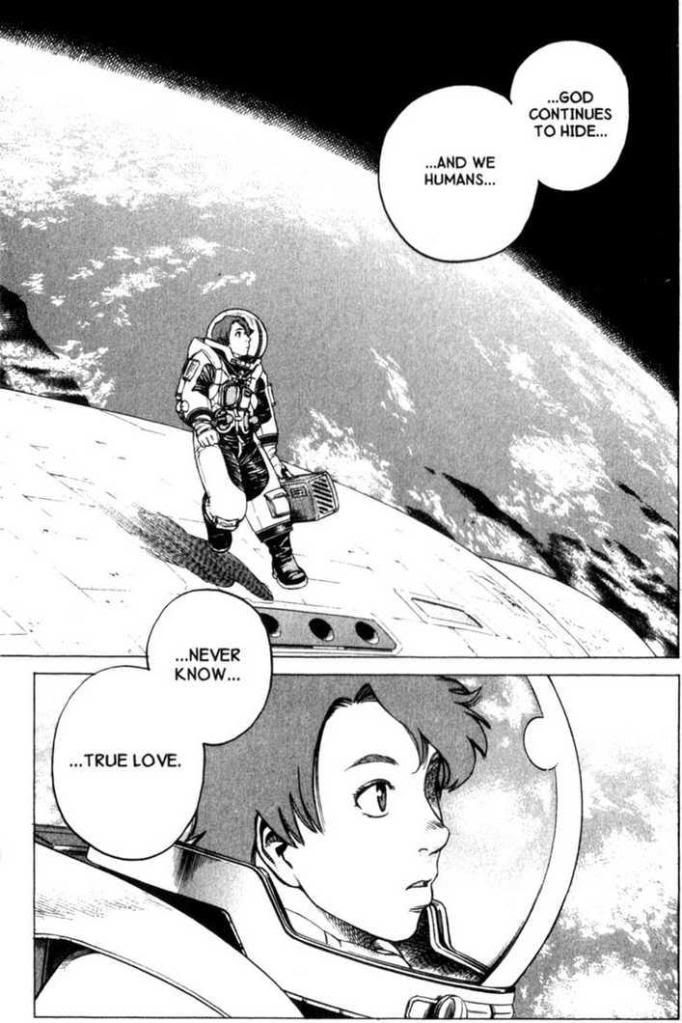 Makoto Yukimura's Planetes is an exceptionally intelligent, enjoyable "hard" sci-fi manga, concerning the low-key adventures of a trio of deep-space "garbage men" tasked with clearing away the clutter and debris left behind by space exploration. The environmentalist idea at the core of the story — that technological advances inevitably have unintended and far-reaching consequences — is only one current in Yukimura's episodic five-book narrative, which is equally involved in the lives and ambitions of the central characters, the various political and revolutionary plots fermenting behind the scenes, and the day-to-day routine of a spaceship crew. The series sketches out a very complex universe, but never gets too bogged down in the details, instead focusing on the rich character relationships. It helps, too, that Yukimura's artwork is absolutely gorgeous, with a hyper-realistic style that lends weight to all the images of gleaming spaceships racing through a dense black void. [buy] | [buy]
Makoto Yukimura's Planetes is an exceptionally intelligent, enjoyable "hard" sci-fi manga, concerning the low-key adventures of a trio of deep-space "garbage men" tasked with clearing away the clutter and debris left behind by space exploration. The environmentalist idea at the core of the story — that technological advances inevitably have unintended and far-reaching consequences — is only one current in Yukimura's episodic five-book narrative, which is equally involved in the lives and ambitions of the central characters, the various political and revolutionary plots fermenting behind the scenes, and the day-to-day routine of a spaceship crew. The series sketches out a very complex universe, but never gets too bogged down in the details, instead focusing on the rich character relationships. It helps, too, that Yukimura's artwork is absolutely gorgeous, with a hyper-realistic style that lends weight to all the images of gleaming spaceships racing through a dense black void. [buy] | [buy]55. INCANTO
by Frank Santoro, 2006
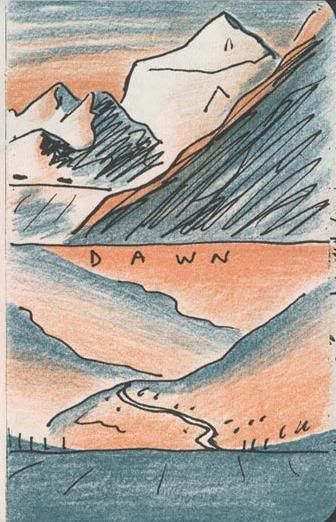 Incanto is a strange little comic, artist Frank Santoro's nearly wordless appropriation of manga-style aesthetics and storytelling, marrying the look and feel of manga to an abstract, experimental approach, stripping down manga's form to a raw essence scribbled across the page. It's a book about moods and feelings, evoking rather than telling a story; its effect is approximate rather than specific. Santoro uses a small palette of colors — just orange and blue — and a deliberately sketchy style to suggest a dreamlike flow of violence, sexuality, horror, memory, nature, separation and reunion. One doesn't so much "read" it as get swept along by the elusive evocations of its images, which occasionally crystallize from the fragmentary linework of hazy, half-remembered dreams into the startling clarity of a particularly important memory. Santoro depicts several landscape scenes with a crayon-and-marker virtuosity that makes them look like romantic children's drawing vistas, standing out with raw potency from the sketchy, indistinct figures who roam through this non-story. [buy]
Incanto is a strange little comic, artist Frank Santoro's nearly wordless appropriation of manga-style aesthetics and storytelling, marrying the look and feel of manga to an abstract, experimental approach, stripping down manga's form to a raw essence scribbled across the page. It's a book about moods and feelings, evoking rather than telling a story; its effect is approximate rather than specific. Santoro uses a small palette of colors — just orange and blue — and a deliberately sketchy style to suggest a dreamlike flow of violence, sexuality, horror, memory, nature, separation and reunion. One doesn't so much "read" it as get swept along by the elusive evocations of its images, which occasionally crystallize from the fragmentary linework of hazy, half-remembered dreams into the startling clarity of a particularly important memory. Santoro depicts several landscape scenes with a crayon-and-marker virtuosity that makes them look like romantic children's drawing vistas, standing out with raw potency from the sketchy, indistinct figures who roam through this non-story. [buy]54. LUMAKICK
by Richard Hahn, 2002-2004
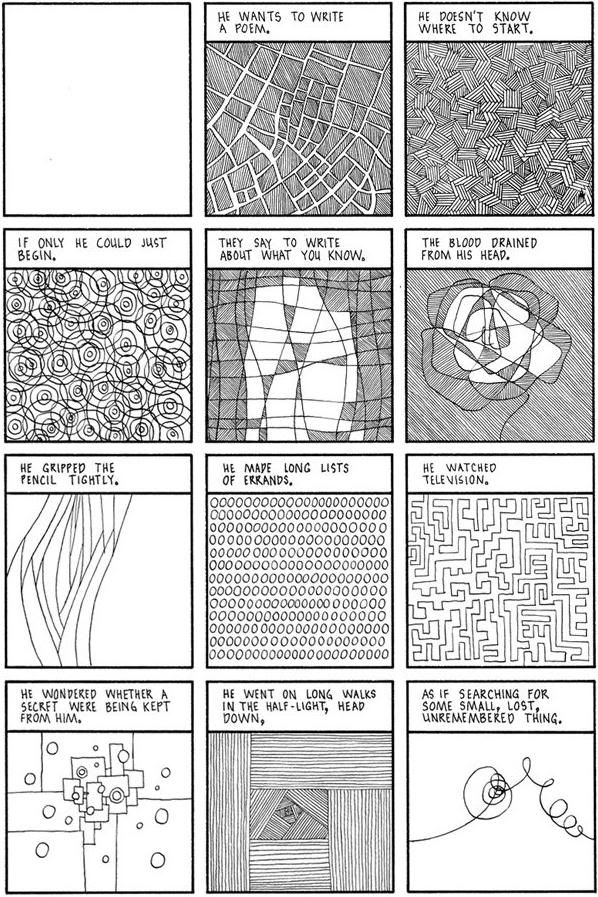 Richard Hahn's poetic comics are among the most original works to come along in years. Hahn's self-published series takes its name from Popeye's mispronunciation of the word "lunatic," and the way this malapropism links Hahn's comics to the history of cartoon iconography makes it a very appropriate moniker for his own work. Not that Hahn is a direct descendent of E.C. Segar in any obvious way, but that he draws upon the basic elements of cartooning in order to craft his own minimalist abstractions and lyrically poetic interludes. The short pieces in the two issues of Lumakick range from enigmatic abstractions to quietly emotional stories in the key of novelist Paul Auster to the deadpan wit of Hahn's recurring characters, the losers Clemenza and Tessio. His minimalist style is equally well-suited to all these varying modes, which coexist comfortably alongside one another. [buy]
Richard Hahn's poetic comics are among the most original works to come along in years. Hahn's self-published series takes its name from Popeye's mispronunciation of the word "lunatic," and the way this malapropism links Hahn's comics to the history of cartoon iconography makes it a very appropriate moniker for his own work. Not that Hahn is a direct descendent of E.C. Segar in any obvious way, but that he draws upon the basic elements of cartooning in order to craft his own minimalist abstractions and lyrically poetic interludes. The short pieces in the two issues of Lumakick range from enigmatic abstractions to quietly emotional stories in the key of novelist Paul Auster to the deadpan wit of Hahn's recurring characters, the losers Clemenza and Tessio. His minimalist style is equally well-suited to all these varying modes, which coexist comfortably alongside one another. [buy]53. MASTERPIECE COMICS
by R. Sikoryak, 2000-2009
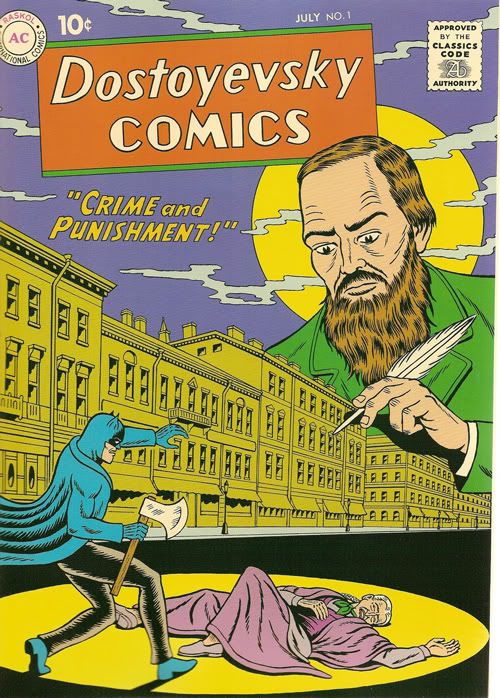 R. Sikoryak is one of the cleverest, sharpest parodists in comics, a chameleon seemingly capable of appropriating any style in order to explore unexpected junction points between pulp culture and fine literature. He's been working in this mode, sporadically, for a long time now, but the 2000s saw some of his best and most fully realized parodies: his retelling of Crime and Punishment through the filter of Batman, his Bronte/EC horror pastiche, his casting of Little Lulu as Hester Prynne's daughter, his existentialist Beevis and Butthead strip. These pieces reveal a sometimes startling thematic continuity between his literary and his trash culture sources, recasting popular antiheroes as literary icons and reveling in the friction sparked off by this fusion. His work is both outrageously funny and unexpectedly revealing, suggesting that high and low culture are more unified than one would expect. [buy]
R. Sikoryak is one of the cleverest, sharpest parodists in comics, a chameleon seemingly capable of appropriating any style in order to explore unexpected junction points between pulp culture and fine literature. He's been working in this mode, sporadically, for a long time now, but the 2000s saw some of his best and most fully realized parodies: his retelling of Crime and Punishment through the filter of Batman, his Bronte/EC horror pastiche, his casting of Little Lulu as Hester Prynne's daughter, his existentialist Beevis and Butthead strip. These pieces reveal a sometimes startling thematic continuity between his literary and his trash culture sources, recasting popular antiheroes as literary icons and reveling in the friction sparked off by this fusion. His work is both outrageously funny and unexpectedly revealing, suggesting that high and low culture are more unified than one would expect. [buy]52. TALES DESIGNED TO THRIZZLE
by Michael Kupperman, 2005-ongoing
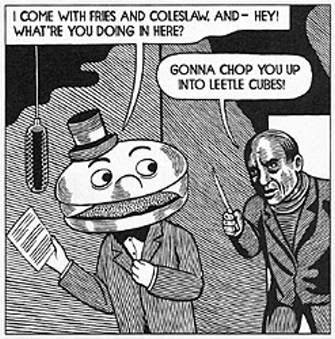 Tales Designed To Thrizzle is Michael Kupperman's latest showcase for his absurdist, Dadaist humor strips, a compendium of bizarre gags and non-sequiturs. Kupperman's lunatic imagination conjures up the unlikely duo of Snake and Bacon, who simply recycle their familiar catch phrases no matter what ridiculous situation they find themselves in. He also concocts whole alternate histories, in whimsical visions of imaginary pasts when a sex-starved populace, deprived of release by constrictive laws, had to turn to loophole refuges like sex blimps and sex holes, taking their illicit sexual encounters either below the ground or high in the air. These absurd scenarios proliferate throughout each issue of Kupperman's series, as he follows each loony premise through to its (il)logical end result. He's a versatile stylist as well, employing a clean aesthetic that shifts from a pastiche of woodcut engravings to the cartoony melange of Snake and Bacon or his Mark Twain caricatures. [buy]
Tales Designed To Thrizzle is Michael Kupperman's latest showcase for his absurdist, Dadaist humor strips, a compendium of bizarre gags and non-sequiturs. Kupperman's lunatic imagination conjures up the unlikely duo of Snake and Bacon, who simply recycle their familiar catch phrases no matter what ridiculous situation they find themselves in. He also concocts whole alternate histories, in whimsical visions of imaginary pasts when a sex-starved populace, deprived of release by constrictive laws, had to turn to loophole refuges like sex blimps and sex holes, taking their illicit sexual encounters either below the ground or high in the air. These absurd scenarios proliferate throughout each issue of Kupperman's series, as he follows each loony premise through to its (il)logical end result. He's a versatile stylist as well, employing a clean aesthetic that shifts from a pastiche of woodcut engravings to the cartoony melange of Snake and Bacon or his Mark Twain caricatures. [buy]51. THE BEAST MOTHER/MOME STORIES
by Eleanor Davis, 2006/2007-2008
 The short stories of Eleanor Davis draw on myth and horror to craft succinct, mysteriously moving little parables, like Grimm fairy tales where the "monsters" are almost always infused with pathos and feeling. In her standalone minicomic The Beast Mother, a grotesque, naked female monster kidnaps and cares for all the children from surrounding towns, bringing them to her cave where she tenderly cares for them. With her lumpy body and distended breasts, she is a caricature of motherly affection, feeling raw needs that she fulfills in the only way she can. The story, told mostly without words, is about a hunter who tracks and kills this beast, thereby freeing her half-feral children so their true parents can reclaim them. The beauty of Davis' story is its moral ambiguity, the way she manages to make this ending bittersweet and emotionally shaded; the hunter seems ambivalent about what he's done, and even the children aren't grateful when he destroys the only mother they ever knew. Only the townspeople are happy, paying off the hunter and gathering up their long-missing kids. The hunter goes off to camp, and who knows what happens to these newly reunited families. There's an air of sadness in this ending, an air of loss. There's a similar emotional complexity at work in the handful of stories Davis has contributed to the anthology MOME. In the best of these short works, illustrated in Davis' striking style with sepia washes for color, a ferryman brings a parade of monsters hauling sacks across the water to a gathering, never questioning what's in the sacks, even though they rustle like something alive. It's a parable about the ordinary man's encounter with horror and evil, and how easy it is not to ask questions, to simply do one's job and go about the prosaic business of one's day as if nothing unusual is going on. It's a resonant piece, asking hard questions about morality and conscience in an accessible, stylish way. This is, perhaps, Davis' greatest strength as an artist. [buy] | [buy] | [buy] | [buy] | [buy]
The short stories of Eleanor Davis draw on myth and horror to craft succinct, mysteriously moving little parables, like Grimm fairy tales where the "monsters" are almost always infused with pathos and feeling. In her standalone minicomic The Beast Mother, a grotesque, naked female monster kidnaps and cares for all the children from surrounding towns, bringing them to her cave where she tenderly cares for them. With her lumpy body and distended breasts, she is a caricature of motherly affection, feeling raw needs that she fulfills in the only way she can. The story, told mostly without words, is about a hunter who tracks and kills this beast, thereby freeing her half-feral children so their true parents can reclaim them. The beauty of Davis' story is its moral ambiguity, the way she manages to make this ending bittersweet and emotionally shaded; the hunter seems ambivalent about what he's done, and even the children aren't grateful when he destroys the only mother they ever knew. Only the townspeople are happy, paying off the hunter and gathering up their long-missing kids. The hunter goes off to camp, and who knows what happens to these newly reunited families. There's an air of sadness in this ending, an air of loss. There's a similar emotional complexity at work in the handful of stories Davis has contributed to the anthology MOME. In the best of these short works, illustrated in Davis' striking style with sepia washes for color, a ferryman brings a parade of monsters hauling sacks across the water to a gathering, never questioning what's in the sacks, even though they rustle like something alive. It's a parable about the ordinary man's encounter with horror and evil, and how easy it is not to ask questions, to simply do one's job and go about the prosaic business of one's day as if nothing unusual is going on. It's a resonant piece, asking hard questions about morality and conscience in an accessible, stylish way. This is, perhaps, Davis' greatest strength as an artist. [buy] | [buy] | [buy] | [buy] | [buy]50. AUTOMATIC KAFKA
by Joe Casey & Ashley Wood, 2002-2003
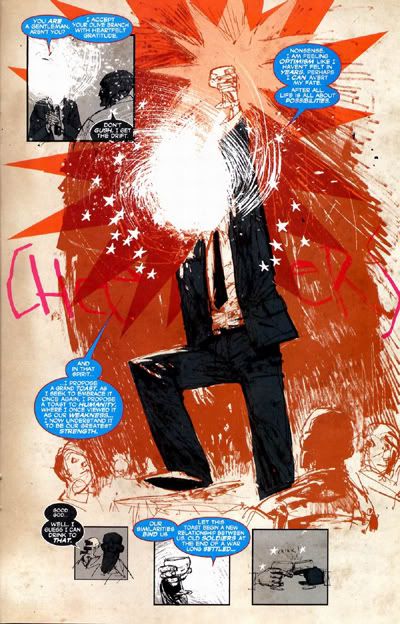 Automatic Kafka is one of many comics to tap into the post-millennial zeitgeist and deliver a frenzied, passionate critique of the junction points between media, superheroes, sex, drugs, war and politics. Like Richard Kelly would later do in film with Southland Tales, writer Joe Casey and artist Ashley Wood mimic the sensory overload and cluttered landscape of modern culture. Wood's art, descended from the Barron Storey/Dave McKean school of sketchy multimedia collage, especially sets the tone, with his frenzied scribblings, bold use of color, and abrupt stylistic shifts. The series — which unfortunately still hasn't been collected to rescue it from oblivion — is a brilliant and scattershot satire centering around a robotic man called Automatic Kafka and his fellow degenerate ex-heroes. Casey's heroes have long ago stopped doing anything remotely heroic, and now instead dedicate themselves to various vices, and to pimping out their celebrity on TV, or as ass-kicking government agents. And they live in a deeply strange world, as reflected by Wood's wild artwork: scorpions deliver cryptic warnings, the panels are surrounded on all sides by commercial advertisements, and a man with a firecracker for a head plots behind the scenes. The apex of his approach comes in the series' third issue, in which the title hero's TV game show is visualized through a manic cluster of slogans and icons threatening to overload and crowd out the actual images of the narrative. It's a smart, funny, provocative, visually stimulating comic that remains very unfairly overlooked.
Automatic Kafka is one of many comics to tap into the post-millennial zeitgeist and deliver a frenzied, passionate critique of the junction points between media, superheroes, sex, drugs, war and politics. Like Richard Kelly would later do in film with Southland Tales, writer Joe Casey and artist Ashley Wood mimic the sensory overload and cluttered landscape of modern culture. Wood's art, descended from the Barron Storey/Dave McKean school of sketchy multimedia collage, especially sets the tone, with his frenzied scribblings, bold use of color, and abrupt stylistic shifts. The series — which unfortunately still hasn't been collected to rescue it from oblivion — is a brilliant and scattershot satire centering around a robotic man called Automatic Kafka and his fellow degenerate ex-heroes. Casey's heroes have long ago stopped doing anything remotely heroic, and now instead dedicate themselves to various vices, and to pimping out their celebrity on TV, or as ass-kicking government agents. And they live in a deeply strange world, as reflected by Wood's wild artwork: scorpions deliver cryptic warnings, the panels are surrounded on all sides by commercial advertisements, and a man with a firecracker for a head plots behind the scenes. The apex of his approach comes in the series' third issue, in which the title hero's TV game show is visualized through a manic cluster of slogans and icons threatening to overload and crowd out the actual images of the narrative. It's a smart, funny, provocative, visually stimulating comic that remains very unfairly overlooked.49. ELVIS ROAD
by Elvis Studio, 2007
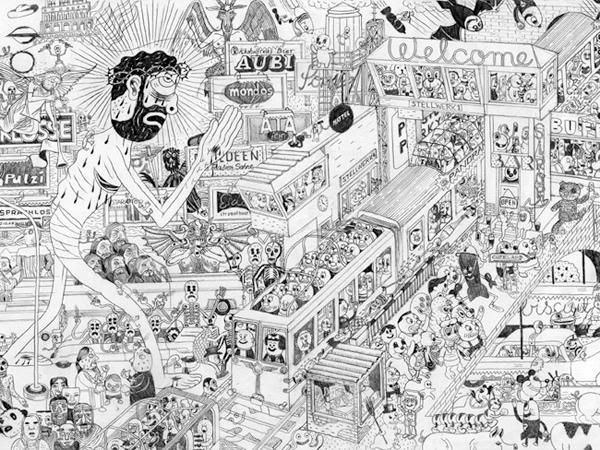 The artistic duo of Helge Reumann and Xavier Robel, together known as Elvis Studio, have a distinctive, obsessively detailed style, crafting sprawling landscapes where something seems to be happening in every corner, every inch, of the drawing. This style reaches its apex in Elvis Road, an ambitious and original book in which the pair drew a lengthy, scrolling crowd scene stretching out across a roll of paper. The book is designed to be read, not in the traditional manner, but as one very long scroll; the accordion-folded pages can unfurl into a single 20-foot-long sheet. Within this epic sprawl, the two artists feverishly doodle out various mini-narratives and scenes that play out inside a wild, apocalyptic framework. Within the chaos, cops and criminals do battle, characters from popular culture and world history make appearances, factories spew smoke, Klansmen and Nazis go on parade, and Jesus and the Devil themselves prepare for epic battle. [buy]
The artistic duo of Helge Reumann and Xavier Robel, together known as Elvis Studio, have a distinctive, obsessively detailed style, crafting sprawling landscapes where something seems to be happening in every corner, every inch, of the drawing. This style reaches its apex in Elvis Road, an ambitious and original book in which the pair drew a lengthy, scrolling crowd scene stretching out across a roll of paper. The book is designed to be read, not in the traditional manner, but as one very long scroll; the accordion-folded pages can unfurl into a single 20-foot-long sheet. Within this epic sprawl, the two artists feverishly doodle out various mini-narratives and scenes that play out inside a wild, apocalyptic framework. Within the chaos, cops and criminals do battle, characters from popular culture and world history make appearances, factories spew smoke, Klansmen and Nazis go on parade, and Jesus and the Devil themselves prepare for epic battle. [buy]48. 100 BULLETS
by Brian Azzarello & Eduardo Risso, 1999-2009
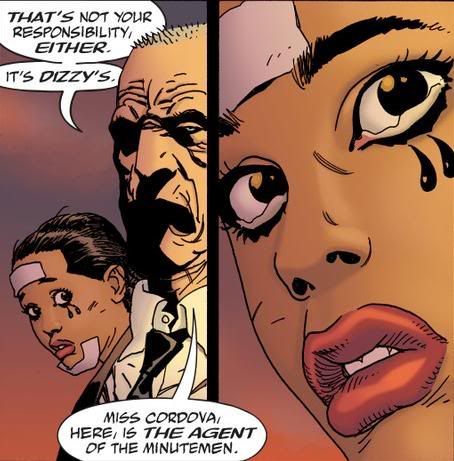 Brian Azzarello's 100-issue crime drama started off as a satisfying high-concept gimmick based around its title: a mysterious man known only as Agent Graves would show up out of nowhere, give some down-and-out malcontent a suitcase, and tell them that it contains both a gun loaded with untraceable bullets and information about a person who wronged them. It plops a moral dilemma into the laps of Graves' selected people. Will they seek revenge? Will they change their lives? Will they use the gun? And, if so, how will they use it? Conceivably, Azzarello — his pulpy, punny writing bolstered by the striking noirish artwork of collaborator Eduardo Risso — could have kept pumping out variations on this formula indefinitely. It's a strong formula and one that allows for nearly infinite stories. Instead, over time Azzarello subtly began revealing the broad outlines of a much bigger, more complex story, a history-spanning intrigue incorporating secret organizations, betrayals, double- and triple- and quadruple-crosses, gangsters, drug lords and the American aristocracy. Ultimately, the series offers up a potent critique of the lust for power, the nearly irresistible drive for various forms of control: money, sexuality, prestige. Throughout its length, the large cast gathers into nebulous alliances, and Azzarello cleverly keeps the multiple plots and subplots up in the air without ever sacrificing characterization or his underlying themes about greed and corruption. Taken as a whole, 100 Bullets is both an utterly engrossing crime/conspiracy thriller and a cogent American satire. [buy] | [buy] | [buy]
Brian Azzarello's 100-issue crime drama started off as a satisfying high-concept gimmick based around its title: a mysterious man known only as Agent Graves would show up out of nowhere, give some down-and-out malcontent a suitcase, and tell them that it contains both a gun loaded with untraceable bullets and information about a person who wronged them. It plops a moral dilemma into the laps of Graves' selected people. Will they seek revenge? Will they change their lives? Will they use the gun? And, if so, how will they use it? Conceivably, Azzarello — his pulpy, punny writing bolstered by the striking noirish artwork of collaborator Eduardo Risso — could have kept pumping out variations on this formula indefinitely. It's a strong formula and one that allows for nearly infinite stories. Instead, over time Azzarello subtly began revealing the broad outlines of a much bigger, more complex story, a history-spanning intrigue incorporating secret organizations, betrayals, double- and triple- and quadruple-crosses, gangsters, drug lords and the American aristocracy. Ultimately, the series offers up a potent critique of the lust for power, the nearly irresistible drive for various forms of control: money, sexuality, prestige. Throughout its length, the large cast gathers into nebulous alliances, and Azzarello cleverly keeps the multiple plots and subplots up in the air without ever sacrificing characterization or his underlying themes about greed and corruption. Taken as a whole, 100 Bullets is both an utterly engrossing crime/conspiracy thriller and a cogent American satire. [buy] | [buy] | [buy]47. EIGHTBALL #23: THE DEATH RAY
by Daniel Clowes, 2004
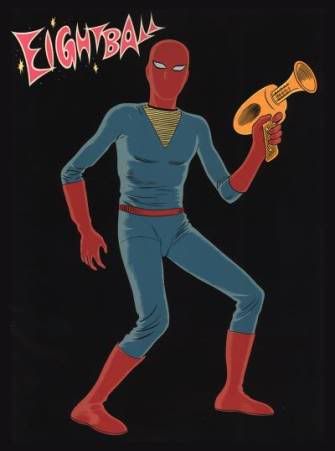 The 23rd (and final, as of now) issue of Daniel Clowes' long-running series Eightball is a self-contained epic in miniature, poking at superhero archetypes, with their ideas about "responsibility" and "right," in order to tell a quiet, maudlin story of loneliness and self-isolation. For Clowes' characters, great power — a "death ray" that can zap anyone out of existence, but which only works for the loner protagonist Andy — never really manages to make things better or change their lives in any appreciable way. Instead, while imagining life as a costumed adventurer putting things right, Andy uses his death ray in small, petty, inconsequential ways, because basically he's a small, petty, inconsequential man. This dark, cynical vision is bolstered by Clowes' clean, austere artistry, particularly his striking use of color, utilizing an array of palettes to convey various memories, fantasies and emotional states. The layout is intriguing as well, eventually drawing together the strands of narrative through the use of seemingly disconnected shorter strips, in numerous styles and from a multitude of perspectives. It's this multiplicity that makes the book more than just another sadsack loser tale. Clowes insists on incorporating the lives of others into Andy's isolated world, allowing the story's ripples to fan out beyond the narrow confines of simple genre parody. Instead, The Death Ray is a poignant lament, and a blistering portrayal of the ways in which people's simplistic understanding of life, love and happiness prevent them from even imagining ambitions beyond their immediate vicinity. [buy]
The 23rd (and final, as of now) issue of Daniel Clowes' long-running series Eightball is a self-contained epic in miniature, poking at superhero archetypes, with their ideas about "responsibility" and "right," in order to tell a quiet, maudlin story of loneliness and self-isolation. For Clowes' characters, great power — a "death ray" that can zap anyone out of existence, but which only works for the loner protagonist Andy — never really manages to make things better or change their lives in any appreciable way. Instead, while imagining life as a costumed adventurer putting things right, Andy uses his death ray in small, petty, inconsequential ways, because basically he's a small, petty, inconsequential man. This dark, cynical vision is bolstered by Clowes' clean, austere artistry, particularly his striking use of color, utilizing an array of palettes to convey various memories, fantasies and emotional states. The layout is intriguing as well, eventually drawing together the strands of narrative through the use of seemingly disconnected shorter strips, in numerous styles and from a multitude of perspectives. It's this multiplicity that makes the book more than just another sadsack loser tale. Clowes insists on incorporating the lives of others into Andy's isolated world, allowing the story's ripples to fan out beyond the narrow confines of simple genre parody. Instead, The Death Ray is a poignant lament, and a blistering portrayal of the ways in which people's simplistic understanding of life, love and happiness prevent them from even imagining ambitions beyond their immediate vicinity. [buy]46. WHAT IT IS
by Lynda Barry, 2008
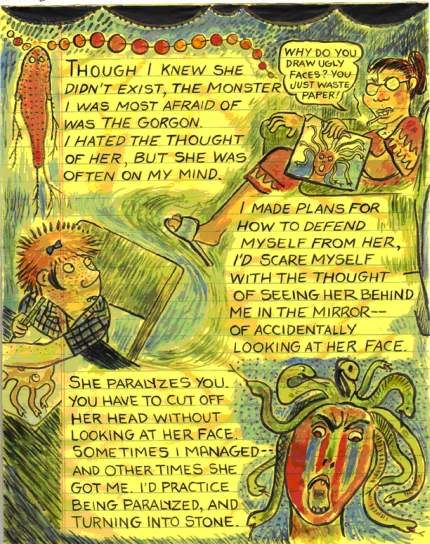 What It Is is a wonderfully inspirational book, a book that's overflowing with creativity and generosity. Barry has essentially crafted a very aesthetically rich "how to" volume that seeks to get people excited about writing and drawing and inventing their own stories. The book is divided into several sections. In the first, Barry alternates between short comics that relate stories from her childhood and collage sequences in which dense patchwork constructions of text and images raise basic questions about memory, imagination, creativity, aesthetics and thought. Barry is constantly suggesting provocative ideas, offering up challenges to the reader, and her tightly packed pages defy traditional reading. Instead, the eye flows freely around her pages, picking up various threads and following them from one idea to the next, letting her web of associations and questions evoke all sorts of images and concepts. This is the book's longest segment, but she follows it with two shorter "how to" sections, in which she lays out several exercises intended to jumpstart creativity and get would-be writers or artists used to the process of telling stories and exploiting the rich veins of memory. Finally, there's an excerpt from Barry's own sketchbook exercises and margin notes. The whole thing would be reminiscent of those vaguely New Agey "anyone can write" motivational seminars, except that Barry has such enthusiasm, and such restless creativity in every page she crafts, that her example is genuinely inspiring and beautiful. [buy]
What It Is is a wonderfully inspirational book, a book that's overflowing with creativity and generosity. Barry has essentially crafted a very aesthetically rich "how to" volume that seeks to get people excited about writing and drawing and inventing their own stories. The book is divided into several sections. In the first, Barry alternates between short comics that relate stories from her childhood and collage sequences in which dense patchwork constructions of text and images raise basic questions about memory, imagination, creativity, aesthetics and thought. Barry is constantly suggesting provocative ideas, offering up challenges to the reader, and her tightly packed pages defy traditional reading. Instead, the eye flows freely around her pages, picking up various threads and following them from one idea to the next, letting her web of associations and questions evoke all sorts of images and concepts. This is the book's longest segment, but she follows it with two shorter "how to" sections, in which she lays out several exercises intended to jumpstart creativity and get would-be writers or artists used to the process of telling stories and exploiting the rich veins of memory. Finally, there's an excerpt from Barry's own sketchbook exercises and margin notes. The whole thing would be reminiscent of those vaguely New Agey "anyone can write" motivational seminars, except that Barry has such enthusiasm, and such restless creativity in every page she crafts, that her example is genuinely inspiring and beautiful. [buy]45. YOTSUBA&!
by Kiyohiko Azuma, 2003-ongoing
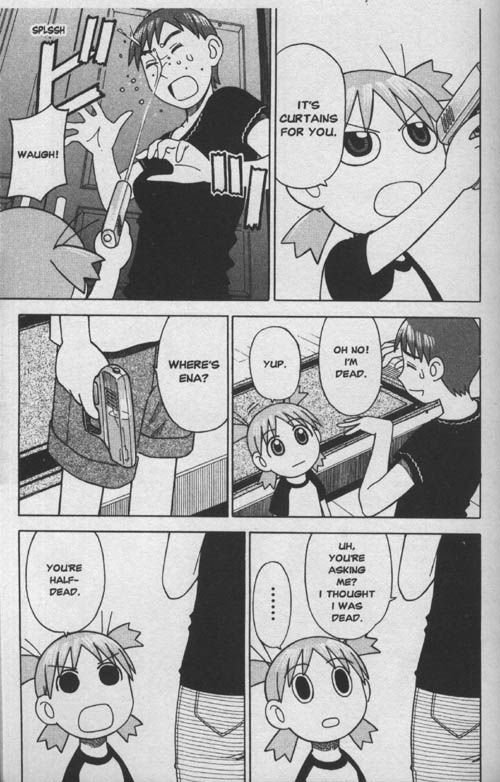 There are few comics as purely joyful and exuberant as Yotsuba&!, a series that's unusual for generating a surprising amount of substance from an especially slight premise. The title character, Yotsuba, is a very happy four-year girl who lives with her adoptive father, a slacker who doesn't always seem to be paying the most careful attention to his perpetually curious, cheerful, somewhat strange little daughter. Yotsuba might be four, but her behavior could best be described as that of a newborn who can talk: she is fascinated by and curious about everything, and she approaches each new discovery with the wide-eyed, gape-jawed, squealing-with-delight reaction it deserves. The book's title thus provides its structure as well. Each more-or-less self-contained chapter revolves around Yotsuba's encounters with a variety of everyday objects, places, concepts and people: Yotsuba & TV, Yotsuba & Shopping, Yotsuba & Drawing, even Yotsuba & Global Warming. The framework is simple, but allows for near-infinite variations. Yotsuba invariably encounters something and then milks every bit of nuance and emotional catharsis from the experience, reacting to life with a voracious and seemingly inexhaustible supply of joy and pleasure. As her bemused father says at one point, smiling with resignation, nothing ever gets Yotsuba down, while seemingly everything surprises and delights her. Kiyohiko Azuma documents Yotsuba's domestic adventures with a clean, attractive style, shifting ably from semi-realist depictions of the natural world to the cartoony exaggerations of Yotsuba at her most emotional. And the book is frequently hilarious; Azuma has a keen comic timing, and a good sense of body language, so that he sets up visual gags perfectly through the rhythms of his panels. These books present a character who enjoys life to its fullest, who appreciates the splendors of the world, of other people, of the simple delights just waiting everywhere to overcome us when we're not expecting it. Within this deceptively simple work is an ode to taking life as it comes and appreciating every day as though the world had been made anew, just for us, every morning. [buy] | [buy]
There are few comics as purely joyful and exuberant as Yotsuba&!, a series that's unusual for generating a surprising amount of substance from an especially slight premise. The title character, Yotsuba, is a very happy four-year girl who lives with her adoptive father, a slacker who doesn't always seem to be paying the most careful attention to his perpetually curious, cheerful, somewhat strange little daughter. Yotsuba might be four, but her behavior could best be described as that of a newborn who can talk: she is fascinated by and curious about everything, and she approaches each new discovery with the wide-eyed, gape-jawed, squealing-with-delight reaction it deserves. The book's title thus provides its structure as well. Each more-or-less self-contained chapter revolves around Yotsuba's encounters with a variety of everyday objects, places, concepts and people: Yotsuba & TV, Yotsuba & Shopping, Yotsuba & Drawing, even Yotsuba & Global Warming. The framework is simple, but allows for near-infinite variations. Yotsuba invariably encounters something and then milks every bit of nuance and emotional catharsis from the experience, reacting to life with a voracious and seemingly inexhaustible supply of joy and pleasure. As her bemused father says at one point, smiling with resignation, nothing ever gets Yotsuba down, while seemingly everything surprises and delights her. Kiyohiko Azuma documents Yotsuba's domestic adventures with a clean, attractive style, shifting ably from semi-realist depictions of the natural world to the cartoony exaggerations of Yotsuba at her most emotional. And the book is frequently hilarious; Azuma has a keen comic timing, and a good sense of body language, so that he sets up visual gags perfectly through the rhythms of his panels. These books present a character who enjoys life to its fullest, who appreciates the splendors of the world, of other people, of the simple delights just waiting everywhere to overcome us when we're not expecting it. Within this deceptively simple work is an ode to taking life as it comes and appreciating every day as though the world had been made anew, just for us, every morning. [buy] | [buy]44. SKYSCRAPERS OF THE MIDWEST
by Joshua Cotter, 2005-2008
 Skyscrapers of the Midwest is Joshua Cotter's loose blend of autobiography and fantasy as a way of evoking the experience of a typical middle American childhood, presumably his own. But instead of assuming a direct autobiographical mode, Cotter turns himself and the rest of his family into anthropomorphized cats — and then further abstracts them by spending much of the book within the head of the deliberately unnamed protagonist, who frequently imagines himself as robot superhero Nova Stealth. A giant-size Nova Stealth also appears as a rather melancholy incarnation of God, a shambling, outdated model who seems to be just going through the motions in continuing to dole out life and death. Obviously, Cotter's ambitions extend beyond mere quotidian slice-of-life drama; his book's clever shifts between stylistic modes reflect a boldly experimental sensibility and an eagerness to visualize childhood's slights and wounds through a child's imaginative mind. As a result, the book is packed with great sequences, with devastating insights, heartbreaking incidents and moments of surprising humor. At the book's climax, Cotter flows so brilliantly from a comic book-inspired fever dream into a poignant vision of the afterlife that this sequence — in which the central protagonist is depicted solely as a silent robot — is utterly overwhelming. [buy]
Skyscrapers of the Midwest is Joshua Cotter's loose blend of autobiography and fantasy as a way of evoking the experience of a typical middle American childhood, presumably his own. But instead of assuming a direct autobiographical mode, Cotter turns himself and the rest of his family into anthropomorphized cats — and then further abstracts them by spending much of the book within the head of the deliberately unnamed protagonist, who frequently imagines himself as robot superhero Nova Stealth. A giant-size Nova Stealth also appears as a rather melancholy incarnation of God, a shambling, outdated model who seems to be just going through the motions in continuing to dole out life and death. Obviously, Cotter's ambitions extend beyond mere quotidian slice-of-life drama; his book's clever shifts between stylistic modes reflect a boldly experimental sensibility and an eagerness to visualize childhood's slights and wounds through a child's imaginative mind. As a result, the book is packed with great sequences, with devastating insights, heartbreaking incidents and moments of surprising humor. At the book's climax, Cotter flows so brilliantly from a comic book-inspired fever dream into a poignant vision of the afterlife that this sequence — in which the central protagonist is depicted solely as a silent robot — is utterly overwhelming. [buy]43. POWR MASTRS
by C.F., 2007-ongoing
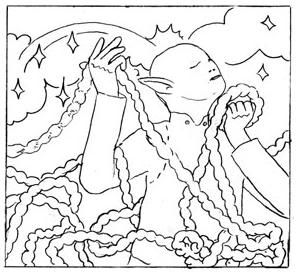 Powr Mastrs is the first real long-form work by artist C.F. (also known as the noise musician Kites). It is an exercise in sci-fi/fantasy world-building, establishing a complicated fictional world with its own rules of magic and technology, and a large interlocking set of characters who perform arcane rituals, reference seemingly rich pasts, and engage in various plots, adventures and daily routines. Drawn in C.F.'s distinctive minimal style, these stories read as though the bored margin doodlings of a high school have come to life, with details filling in and characters acquiring personalities and back stories of their own. C.F.'s faux-naif style, stripped-down and with a great deal of white space, lends an air of childlike enthusiasm and imagination to his stories. With the second volume, C.F. introduced spot watercolor to his black-and-white drawings, a welcome addition since the best of his previous work has always exploited his feel for color. In these first two volumes, it still feels like C.F. is setting the groundwork for a complex epic to come, introducing characters and establishing relationships. But on the other hand one can equally easily imagine a whole series like this, in which grand dramas are subsumed by the surreal daily life of this imaginary land. [buy] | [buy]
Powr Mastrs is the first real long-form work by artist C.F. (also known as the noise musician Kites). It is an exercise in sci-fi/fantasy world-building, establishing a complicated fictional world with its own rules of magic and technology, and a large interlocking set of characters who perform arcane rituals, reference seemingly rich pasts, and engage in various plots, adventures and daily routines. Drawn in C.F.'s distinctive minimal style, these stories read as though the bored margin doodlings of a high school have come to life, with details filling in and characters acquiring personalities and back stories of their own. C.F.'s faux-naif style, stripped-down and with a great deal of white space, lends an air of childlike enthusiasm and imagination to his stories. With the second volume, C.F. introduced spot watercolor to his black-and-white drawings, a welcome addition since the best of his previous work has always exploited his feel for color. In these first two volumes, it still feels like C.F. is setting the groundwork for a complex epic to come, introducing characters and establishing relationships. But on the other hand one can equally easily imagine a whole series like this, in which grand dramas are subsumed by the surreal daily life of this imaginary land. [buy] | [buy]42. ABSTRACT COMICS: THE ANTHOLOGY
by Andrei Molotiu (editor) & various, 2009
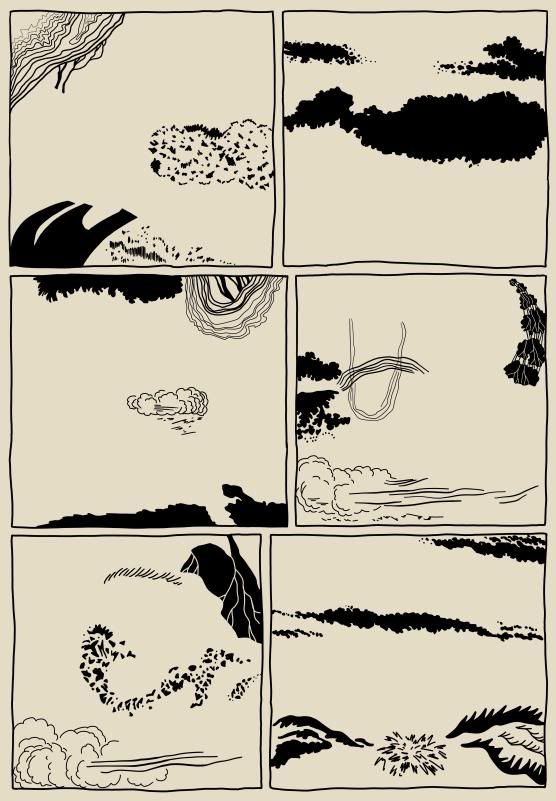 Abstract Comics is an important book because it gathers in one place a persuasive argument for thinking about comics, not in terms of narrative or even figuration, but as pure sequences of images with complicated and ambiguous relationships between one image and the next. Editor Andrei Molotiu believes firmly in abstract comics — comics with no narrative throughline or even "unified narrative space," as his introduction puts it. The anthology then presents an overview of this nascent field, ranging from freshly commissioned pieces to classic examples, and encompassing artists who have never worked in the form before, artists whose work has occasionally flirted with abstraction, and those who have, mostly in recent years, created whole bodies of work meeting Molotiu's definition of abstract comics. They are comics where the sequence is everything, where the pure flow of images is the whole content of the experience. These pieces cannot really be "read" in the conventional sense, but rather challenge viewers to come up with whole new ways of appreciating and understanding them, encouraging a reading experience somewhere between looking at a painting and reading a sequential narrative. Maybe it's the experience of looking at a series of paintings in order.
Abstract Comics is an important book because it gathers in one place a persuasive argument for thinking about comics, not in terms of narrative or even figuration, but as pure sequences of images with complicated and ambiguous relationships between one image and the next. Editor Andrei Molotiu believes firmly in abstract comics — comics with no narrative throughline or even "unified narrative space," as his introduction puts it. The anthology then presents an overview of this nascent field, ranging from freshly commissioned pieces to classic examples, and encompassing artists who have never worked in the form before, artists whose work has occasionally flirted with abstraction, and those who have, mostly in recent years, created whole bodies of work meeting Molotiu's definition of abstract comics. They are comics where the sequence is everything, where the pure flow of images is the whole content of the experience. These pieces cannot really be "read" in the conventional sense, but rather challenge viewers to come up with whole new ways of appreciating and understanding them, encouraging a reading experience somewhere between looking at a painting and reading a sequential narrative. Maybe it's the experience of looking at a series of paintings in order. In any event, the book features some truly stunning and imaginative work: the organic blobs of Anders Pearson, the Duchampesque watercolor scrawls of Casey Camp, Henrik Rehr's shifting currents of densely packed lines, Mike Getsiv's suggestive, boldly colored swirls, Warren Craghead and Richard Hahn's mastery of panel rhythms, the unexpected visual gag inserted into Geoff Grogan's multimedia collage, Alexey Sokolin's forbidding stormclouds of black scratching, Andy Bleck's sensual scribble figures, Derik Badman's renderings of only background fragments from old Tarzan comics, the multiple contributors who turned in dense, virtuoso ink pieces towards the end of the book. Not everything here is at the same high level, but it's a surprisingly consistent anthology, unified by its theme and Molotiu's commitment to including pieces that advance his definition of this particular approach to comics. What's best about the book is how open its territory ultimately is, how much room it leaves for artists to come up with their own ideas about abstraction and sequence. It is a truly groundbreaking book that points the way towards a whole new conception of comics and challenges readers and artists alike to explore this new area. [buy]
41. ASTERIOS POLYP
by David Mazzucchelli, 2009
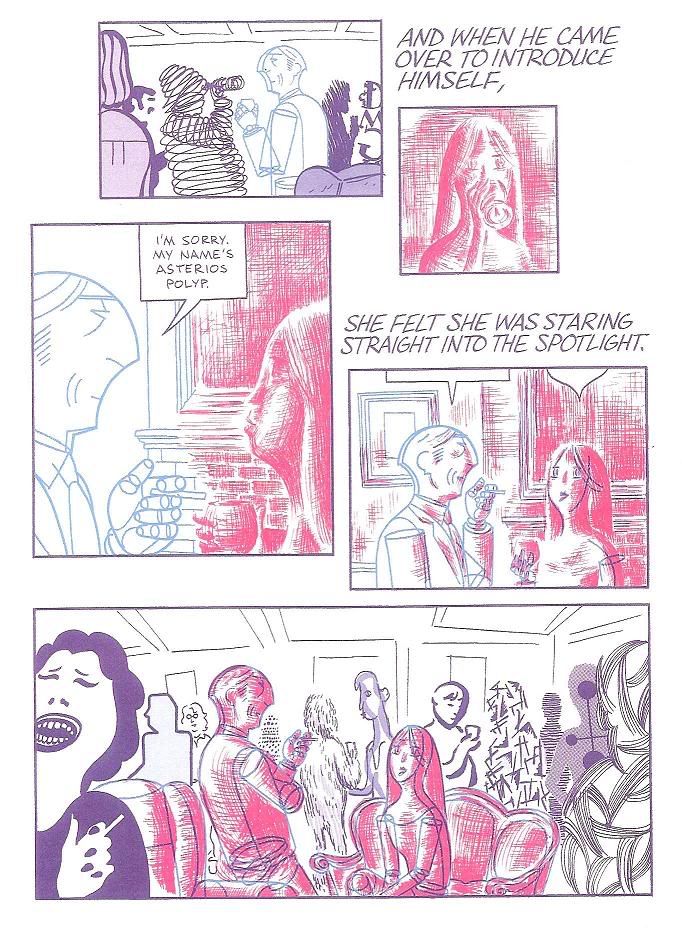 David Mazzucchelli is a master of comics form, so his first long-form work is of course reason to rejoice. Asterios Polyp is the work that everyone has been waiting for from Mazzucchelli, a formalist masterpiece whose cartooning gestures and densely layered sight gags provide visual delight on nearly every page. The title character is a pompous failed architect who, wallowing in self-pity following his divorce from his beloved Hana, sets off to abandon his former life, while compulsively returning to the past in painful memories and dreams. Ostensibly narrated by Asterios' stillborn twin, who periodically shows up as a dotted-line absence standing next to his living brother — yes, this is a very high-concept work — the book deploys one bold storytelling device after another as Mazzucchelli cleverly probes the relationship between Asterios and Hana. One of the book's best devices is the way every character is drawn in a subtly different style, complete with distinctively varied font styles for their dialogue. Thus the hard lines of Asterios and the fluid curves of Hana clearly set them up as opposites, as does the fact that, during their first meeting and on occasion afterwards, Asterios is drawn as a conglomeration of blue polygons while Hana is red and sketchy. When they're connecting and falling in love, Mazzucchelli depicts their two worlds coming together, her red crosshatching filling in his polygons, his clean blue lines infiltrating her more rounded form. It's an elegant visual metaphor for the idea that each individual sees the world differently, and that reconciling two different worldviews in a relationship can be a great challenge. Mazzucchelli packs the book with clever visual touches like this, casually evoking Will Eisner or Frank King with his layouts, or drawing a train worker's irate word balloon so it resembles the MTA logo, or using a dotted line to fill in the missing portion of a broken beer bottle. Each page offers up surprises and flights of fancy, and Mazzucchelli's panels are stuffed with clever details that enrich his characters, fill in the narrative, or simply offer up a diverting chuckle. It's a fun, innovative book, not so much for its story (which is rather typical at heart) but for the ways in which Mazzucchelli breathes new life into familiar situations and characters, simply through the grace and beauty of his art. [buy]
David Mazzucchelli is a master of comics form, so his first long-form work is of course reason to rejoice. Asterios Polyp is the work that everyone has been waiting for from Mazzucchelli, a formalist masterpiece whose cartooning gestures and densely layered sight gags provide visual delight on nearly every page. The title character is a pompous failed architect who, wallowing in self-pity following his divorce from his beloved Hana, sets off to abandon his former life, while compulsively returning to the past in painful memories and dreams. Ostensibly narrated by Asterios' stillborn twin, who periodically shows up as a dotted-line absence standing next to his living brother — yes, this is a very high-concept work — the book deploys one bold storytelling device after another as Mazzucchelli cleverly probes the relationship between Asterios and Hana. One of the book's best devices is the way every character is drawn in a subtly different style, complete with distinctively varied font styles for their dialogue. Thus the hard lines of Asterios and the fluid curves of Hana clearly set them up as opposites, as does the fact that, during their first meeting and on occasion afterwards, Asterios is drawn as a conglomeration of blue polygons while Hana is red and sketchy. When they're connecting and falling in love, Mazzucchelli depicts their two worlds coming together, her red crosshatching filling in his polygons, his clean blue lines infiltrating her more rounded form. It's an elegant visual metaphor for the idea that each individual sees the world differently, and that reconciling two different worldviews in a relationship can be a great challenge. Mazzucchelli packs the book with clever visual touches like this, casually evoking Will Eisner or Frank King with his layouts, or drawing a train worker's irate word balloon so it resembles the MTA logo, or using a dotted line to fill in the missing portion of a broken beer bottle. Each page offers up surprises and flights of fancy, and Mazzucchelli's panels are stuffed with clever details that enrich his characters, fill in the narrative, or simply offer up a diverting chuckle. It's a fun, innovative book, not so much for its story (which is rather typical at heart) but for the ways in which Mazzucchelli breathes new life into familiar situations and characters, simply through the grace and beauty of his art. [buy]The second part of this list, encompassing numbers 40-21, has now been posted here. The top 20 is here.

24 comments:
This is great, Ed. I've been wanting to get back into comics, at least a bit, and this provides me with a great list to pick from. Thanks for putting this together.
Thanks, Bill. That's the idea: there are so many great comics out there these days, I really wanted to highlight some of the ones that really blow me away.
I'll probably start with 100 BULLETS. I already knew about that one, but you've really sold me on it. I think that's an easy, genre-based re-entry point. That, and Y: THE LAST MAN, which I've been wanting to pick up for a while now.
That's quite an impressive and varied list you have so far, Ed. I especially appreciate the detailed overview of each, as it kind of helps me determine which I may want to give a try and which I'm not as likely to get into -- I TRY to read more abstract/avant-garde comics, since they are often highly rated in lists like yours and I've yet to find too many that do much for me. I guess I'm more of a narrative person with my comics than a true formalist.
Part of that comes from mostly reading superhero stuff until a few years back (and I've not read anything new for at least a year now), so although I've heard of many of these choices, I've only ever read SLEEPER, parts of 100 BULLETS, and EIGHTBALL #23 (and the CEREBUS of old...I'm not sure I want to read crazy Dave's rantings and ravings in the issues you mention).
Of the others you mention, I've added a few to my "to read" list -- MASTERPIECE COMICS, TALES DESIGNED TO THRIZZLE, SKYSCRAPERS OF THE MIDWEST, and ASTERIOS POLYP. Can't wait to see what else you have in store here.
Oh, and shocked to see YOTSUBA&! on there, as I've always heard it described as a populist kids manga, but you make it sound like a fun all-ages story with the type of protagonist I typically love (shades of WALL-E there?). I may have to give that a try at some point as well.
Too bad I know absolutely nothing about this subject or my 'cheerleading' stance could be more resonant. But I know what true passion is and in your case it informs a presentation that at least equals your greatest film writing. I scanned it, but still was amazed by the information and judgement you impart. The layout, the compelling discussion, and the expertise is really a wonderment to behold on this or any blog.
And what great additions there from Troy too!
Bill, those are two great starting points, since both are accessible and entertaining as hell. I think you'd dig those, especially the pulpy, noirish 100 Bullets, which seems made for you if ever a comic was.
Troy, I figured you'd be stopping by since I'd heard you were a comics fan! Obviously, my own preferences lean heavily towards the art-comics, formalist side of things, though there's still going to be plenty of more accessible, narrative-based work on this list as well. I came to comics pretty much as an adult, after having read some superhero stuff as a kid, and I quickly gravitated towards the artier aspects of the medium once I started reading them again.
The ones you mention are all great, fairly accessible books, and there should be some more stuff you'd likely enjoy further up the list. I'd be curious to hear your (and Bill's) take on any of these books if you guys do wind up checking some of this stuff out.
Yotsuba&! is obviously the oddball choice here, and it could fairly be called a "populist kids manga" I suppose. I'm not a big manga guy in general but I do like some selected titles, and this one really took me totally by surprise. It's just such a fun, funny book, so pure and joyous, that it's kind of hard to resist.
Sam, thanks for the praise, I really appreciate it.
Great work, Ed!
Among the graphic novels/comic strips you mentioned, I've head of only a few & haven't read even one. Nonetheless, I enjoyed reading your post.
Looking forward to the remainder of your list.
Thanks, Shubhajit. I'm glad you've enjoyed the list so far and I hope it points you towards a few books to investigate further.
Highly impressive project you have here Ed. Unfortunately, I know nothing about comics as an art form, but your dense descriptions entice me. Maybe I'll start by reading whatever you place at #1, and if I enjoy it, I'll continue on from there.
Hm. Now I'm curious about trying to guess what #1 is going to be. The only comic that jumps to mind that wouldl have been a suitable guess is actually a few years outside of the scope of this piece.
Hm. Must think, must think...
Yeah, there's still a ton of the "usual suspects" he hasn't mentioned, most of which are deserving and seem to be in line with Ed's tastes. I have my guess at what #1 will be...should be fun to see how it turns out.
Ed, I think you actually have me me interested in reading comics for the first time in a while!
Thanks, Carson, I hope you do take a look at what comics have to offer as a result of this list. The #1 pick, when we get there, is a pretty good choice for a starting point, and there are several others along the way that would provide relatively accessible entryways as well.
Bill, what was your thought for a non-2000s #1? Just out of curiosity.
Troy, I think you, and everyone else, might be surprised by some of the non-"usual suspects" in the top tiers of this list.
I don't want to add to the chorus of "don't really know anything about comics, but loved this piece" but here we are. I was going to list specific comics that looked particularly interesting to me, but to be honest you make me want to read every one of them, though I may be picking up Skyscrapers of the Midwest first.
Ed - My guess would have been FROM HELL. Which would certainly get my own vote, were I allowed to.
Now I can only assume you're #1 pick for the 2000s will be INFINITE CRISIS.
Thanks, Krauthammer, I'm glad this list is making people think about checking out some of these books.
Bill, From Hell would be my choice for best comic of all-time, if I was crazy enough to attempt a list that all-encompassing. So, yeah, it's amazing. I don't want to spoil it, but #1 is *definitely* one of the Crisis books. But which one? Those DC superheroes sure do have a lot of crises. Heh.
Ed, the fact that you, someone who has read an insanely greater number of comics than I have, feels that FROM HELL is the best you've ever read, then I feel much more solid in my own matching opinion. FROM HELL is beyond extraordinary. Everybody must must must read it. Please, for God's sake, disregard the film. The comic is an astonishing work of art, on par with the great 20th century novels I've read.
I'm afraid I got into comics just as the economy bottomed out last year, so I dropped the habit as quickly as I'd picked it up. But I'm always game for anything by Alan Moore, Brian K. Vaughan and Ed Brubaker. There are others, but these are my favorite of the few writers still going strong today that float my boat.
I think we've talked about our love for From Hell before, Bill. I agree: everyone should read it. No one could have any doubts about comics as an artform after reading that.
Jake, it can definitely be an expensive habit, especially with so much great stuff coming out. Of those you name, Moore is obviously one of my favorites, his stuff is always fascinating. Vaughan and Brubaker have a lot of great stuff, too, they're both talented genre writers.
Ed, I must admit that I don't read too many comics anymore. With that said, someone gave me Barry's The Greatest Of Marlys for Christmas and it was spectacular. I'll have to check out What It Is.
Ed, this is truly wonderful and like other people here it may re-kickstart my interest in comics.
I must be honest and say that the art form in general has not impressed me, though most of the examples you write so eloquently about I have not heard of. Little is written about the work of the last few years (especially with a keen, retrospective eye) and that makes your list all the more valuable.
I know it was not made in the last decade, but I believe the comic / manga art form may well be home to Hayao Miyazaki's greatest work - Nausicaa of the Valley of the Wind. The drawings may not have the striking quality, or crazy (sophomoric) inventivity of others, but they perfectly convey his unparalleled gifts as a storyteller.
Doniphon, I haven't read that particular Barry book, but she's definitely great in general, very warm and funny and inventive in her artwork. What It Is is a challenging read, but very worthwhile.
Stephen, I think a lot of people come away from comics unimpressed because it's sometimes so hard to find the good stuff: as you say, there's relatively little serious writing about this artform, especially in comparison to film, and the most popular, high-profile things (like most superhero comics) tend to be, um, not so great. And if you walk into most bookstores, the comics section isn't usually overflowing with the best stuff, but with tons of mediocre manga and slick Marvel/DC collections. I hope this list points you towards an alternative.
It's been a long time since I've read the Miyazaki series, so I should probably revisit it soon. But I remember being very impressed by his art; I love Moebius so his Moebius-influenced fantasy style is right up my alley.
Great list so far. Interesting to see AUTOMATIC KAFKA on here. The series never really grabbed me in the way I'd hoped it would, given the creative team. But I have to admit that the Charlie Brown issue has stuck with me.
Thanks, Matt, I'm glad you've enjoyed the list. Automatic Kafka is one that few people would probably rate as highly as I do, but I love its satirical dark humor and, especially, that stunning artwork.
This is a great list-- some online vendors should thank you since I went and bought some of these things right away! I used to work in a comic book store but am not "in the loop" as much these days, but I knew your list had to be good since you had my all time faves represented, Eightball, Jim, and Ganges, among others that you got covered (and yes I do like some superhero stuff too). I would also recommend to anyone who likes these the various compilations put out by Drawn and Quarterly ("Showcase"), always quality. Others to consider might be Persepolis, and Berlin. Will enjoy reading the others on your list!
Post a Comment